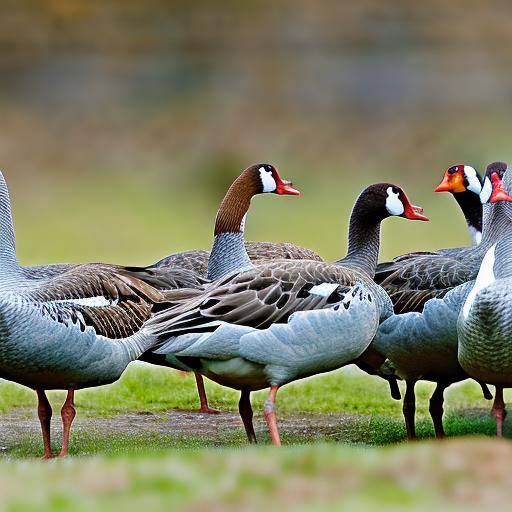Aggressive geese behavior is a topic that is often overlooked but is important to understand for anyone who may come into contact with these birds. Geese are known for their territorial nature and can become aggressive when they feel threatened or when they are protecting their nests or young. It is crucial to have a basic understanding of their behavior in order to avoid potential conflicts and ensure the safety of both humans and geese.
Key Takeaways
- Aggressive geese can be territorial and protective of their nests and young.
- Signs of aggression in geese include hissing, flapping wings, and charging.
- Aggressive geese can cause injuries and pose a danger to humans, especially children.
- To avoid aggressive geese, keep a safe distance and avoid approaching their nests or young.
- If attacked by a goose, protect your face and eyes and try to back away slowly.
Understanding the behavior of aggressive geese
Geese exhibit aggressive behavior for various reasons, including territoriality, protection of their young, and mating behavior. Understanding these behaviors can help individuals anticipate and avoid potential conflicts with geese.
Territorial behavior is one of the main reasons why geese can become aggressive. They establish territories and defend them against intruders, whether it be other geese or humans. Geese are highly protective of their nesting sites and will aggressively defend them from any perceived threats.
Protective behavior is another common reason for aggression in geese. When geese have young goslings, they become extremely protective and will aggressively chase away anything they perceive as a threat to their offspring. This behavior is especially prevalent during the nesting season.
Mating behavior can also lead to aggression in geese. During the breeding season, male geese can become territorial and aggressive towards other males in order to establish dominance and attract a mate. This aggression can sometimes spill over onto humans if they are perceived as a threat.
How to identify aggressive geese
Identifying aggressive geese can help individuals take appropriate precautions to avoid potential conflicts. There are several ways to identify aggressive geese, including physical characteristics, vocalizations, and body language.
Physically, aggressive geese may appear larger than non-aggressive geese due to their raised feathers and extended wings. They may also exhibit a more upright posture and hold their heads high. Additionally, aggressive geese may hiss or honk loudly as a warning sign.
Vocalizations can also be a clue to identifying aggressive geese. Aggressive geese may make loud honking or hissing sounds when they feel threatened or are trying to establish dominance. These vocalizations are often accompanied by aggressive body language.
Body language is another important indicator of aggression in geese. Aggressive geese may lower their heads, extend their necks, and puff up their feathers to appear larger and more intimidating. They may also charge or chase after perceived threats.
The dangers of encountering aggressive geese
Encountering aggressive geese can pose several dangers, including physical injuries, psychological impact, and even legal consequences.
Physically, aggressive geese can cause injuries to humans. Their sharp beaks and strong wings can cause cuts, bruises, and even broken bones. In some cases, geese have been known to bite or peck at humans, causing painful injuries.
The psychological impact of encountering aggressive geese should not be underestimated. Being chased or attacked by a goose can be a frightening experience and can lead to anxiety or fear of encountering geese in the future. This can have a lasting impact on individuals and may affect their enjoyment of outdoor spaces where geese are present.
There can also be legal consequences for harming or harassing geese. In many areas, geese are protected under wildlife conservation laws, and intentionally harming them can result in fines or other legal penalties. It is important to understand the laws and regulations regarding geese in your area to avoid any legal issues.
Tips for avoiding aggressive geese
To avoid potential conflicts with aggressive geese, there are several tips that individuals can follow:
1. Keep a safe distance: It is important to maintain a safe distance from geese, especially if they are exhibiting signs of aggression. This will help minimize the risk of being attacked or injured.
2. Avoid eye contact: Direct eye contact can be seen as a threat by geese and may provoke aggressive behavior. It is best to avoid making direct eye contact with geese and instead focus on moving away slowly and calmly.
3. Do not feed them: Feeding geese can encourage them to become dependent on humans for food and can lead to more aggressive behavior. It is best to avoid feeding geese and instead allow them to find their own natural food sources.
What to do if you are attacked by a goose

If you find yourself being attacked by a goose, it is important to stay calm and take appropriate actions to protect yourself:
1. Stay calm: It is important to remain calm and avoid panicking. Panicking can escalate the situation and may provoke the goose further.
2. Protect your face and eyes: If a goose is attacking, cover your face and eyes with your hands or any available object, such as a jacket or bag. This will help protect vulnerable areas from potential pecks or bites.
3. Retreat slowly: Back away slowly from the goose without turning your back on it. Moving slowly and calmly will help minimize the risk of further aggression.
How to protect yourself and others from aggressive geese
In order to protect yourself and others from aggressive geese, there are several strategies that can be implemented:
1. Use barriers: Physical barriers, such as fences or hedges, can help prevent geese from entering areas where they may pose a threat to humans. These barriers can help create a safe space for both humans and geese.
2. Install warning signs: Placing signs in areas where geese are known to be aggressive can help alert individuals to the potential dangers and encourage them to take appropriate precautions.
3. Educate others: Spreading awareness about the behavior of aggressive geese can help educate others on how to avoid potential conflicts. This can be done through community outreach programs, informational brochures, or online resources.
The importance of keeping your distance from geese
Respecting the space of geese is crucial for coexisting with them in a safe and respectful manner. There are several reasons why it is important to keep a distance from geese:
1. Respect their space: Geese, like any other wildlife, have their own territories and personal space. Respecting their boundaries and giving them the space they need is essential for their well-being.
2. Avoid disrupting their habitat: Approaching geese too closely can disrupt their natural habitat and cause stress. By keeping a safe distance, individuals can help minimize disturbances to their environment.
3. Do not approach their nests: Geese are highly protective of their nests and may become aggressive if they feel threatened. It is important to avoid approaching or disturbing their nests to ensure the safety of both humans and geese.
The role of territorial behavior in aggressive geese
Territorial behavior plays a significant role in the aggression displayed by geese. Understanding this behavior can help individuals manage potential conflicts more effectively:
1. Importance of defending their territory: Geese establish territories to ensure access to resources and suitable nesting sites. Defending their territory is crucial for their survival and reproductive success.
2. Understanding their boundaries: Geese have specific boundaries for their territories, and they will defend these boundaries against intruders. By understanding these boundaries, individuals can avoid entering areas where geese may become aggressive.
3. Strategies for managing territorial behavior: Implementing strategies such as habitat modification or creating designated areas for geese can help manage territorial behavior and reduce potential conflicts with humans.
The impact of human interaction on geese aggression
Human interaction can have a significant impact on the aggression displayed by geese:
1. Negative effects of feeding geese: Feeding geese can lead to increased aggression as they become dependent on humans for food. It can also disrupt their natural foraging behaviors and lead to overpopulation in certain areas.
2. Importance of responsible behavior: It is important for individuals to behave responsibly around geese and avoid actions that may provoke aggression. This includes not feeding them, respecting their space, and following any regulations or guidelines in place.
3. Strategies for minimizing human impact: Implementing educational programs, enforcing regulations, and promoting responsible behavior can help minimize the negative impact of human interaction on geese aggression.
Strategies for managing aggressive geese populations
Managing aggressive geese populations is essential for maintaining a balance between humans and wildlife:
1. Habitat modification: Modifying habitats to make them less attractive to geese can help reduce conflicts. This can include removing food sources, altering landscaping, or creating barriers to prevent access to certain areas.
2. Egg addling: Egg addling involves removing or treating goose eggs to prevent them from hatching. This can help control population growth and reduce aggression associated with nesting behavior.
3. Relocation: In some cases, relocating geese to areas where they are less likely to come into conflict with humans may be necessary. This should be done by trained professionals following appropriate guidelines and regulations.
Understanding aggressive geese behavior is crucial for anyone who may come into contact with these birds. By understanding their behavior, individuals can take appropriate precautions to avoid potential conflicts and ensure the safety of both humans and geese. It is important to respect their space, avoid feeding them, and educate others on responsible behavior around geese. By coexisting with wildlife in a safe and respectful manner, we can create a harmonious environment for both humans and geese.
If you’re dealing with aggressive geese while taking a stroll, you might find this article on poultrywizard.com helpful. It provides valuable insights on how to keep chickens safe and secure in a chicken coop. Understanding the dynamics of a chicken coop can give you ideas on how to create a safe space for yourself when encountering aggressive geese. Check out the article here for more information.
FAQs
What are aggressive geese?
Aggressive geese are geese that exhibit hostile behavior towards humans or other animals. This behavior can include hissing, biting, and chasing.
Why do geese become aggressive?
Geese may become aggressive for a variety of reasons, including feeling threatened or protecting their territory or young. They may also become aggressive if they have been fed by humans and have become accustomed to being fed.
How can I avoid being attacked by aggressive geese?
To avoid being attacked by aggressive geese, it is best to give them plenty of space and avoid approaching them. If you must walk near them, try to walk in a wide arc around them and avoid making direct eye contact.
What should I do if I am attacked by aggressive geese?
If you are attacked by aggressive geese, try to protect your face and eyes and back away slowly. Do not run, as this may encourage the geese to chase you. If you are unable to escape, use an object such as a jacket or umbrella to protect yourself.
Can aggressive geese be trained to be less aggressive?
It is possible to train geese to be less aggressive, but it can be difficult and time-consuming. It is best to avoid feeding geese and to give them plenty of space to avoid triggering their aggressive behavior.
Meet Walter, the feathered-friend fanatic of Florida! Nestled in the sunshine state, Walter struts through life with his feathered companions, clucking his way to happiness. With a coop that’s fancier than a five-star hotel, he’s the Don Juan of the chicken world. When he’s not teaching his hens to do the cha-cha, you’ll find him in a heated debate with his prized rooster, Sir Clucks-a-Lot. Walter’s poultry passion is no yolk; he’s the sunny-side-up guy you never knew you needed in your flock of friends!







